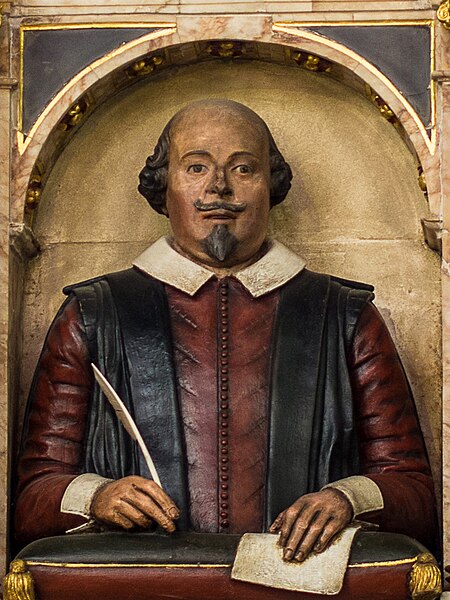No contemporary physical description of William Shakespeare is known to exist. The two portraits of him that are the most famous are the engraving that appears on the title-page of the First Folio, published in 1623, and the other is the sculpture that adorns his memorial in Stratford upon Avon, which dates from before 1623. Experts and critics have argued that several other paintings from the period may represent him, and more than 60 portraits purporting to be of Shakespeare were offered for sale to the National Portrait Gallery within four decades of its foundation in 1856, but in none of them has Shakespeare's identity been proven.
From farthest left to right: The Cobbe portrait (1610), The Chandos portrait (early 1600s) and the Droeshout portrait (1622): three of the most prominent of the reputed portraits of William Shakespeare.
The Droeshout Portrait of William Shakespeare, from the First Folio
Bust of Shakespeare at Shakespeare's funerary monument
The Chandos portrait
William Shakespeare was an English playwright, poet, and actor. He is widely regarded as the greatest writer in the English language and the world's pre-eminent dramatist. He is often called England's national poet and the "Bard of Avon". His extant works, including collaborations, consist of some 39 plays, 154 sonnets, three long narrative poems, and a few other verses, some of uncertain authorship. His plays have been translated into every major living language and are performed more often than those of any other playwright. Shakespeare remains arguably the most influential writer in the English language, and his works continue to be studied and reinterpreted.
The Chandos portrait, likely Shakespeare, early 17th century
John Shakespeare's house, believed to be Shakespeare's birthplace, in Stratford-upon-Avon
Shakespeare's coat of arms, from the 1602 book The book of coates and creasts. Promptuarium armorum. It features spears as a pun on the family name.
Shakespeare's funerary monument in Stratford-upon-Avon







